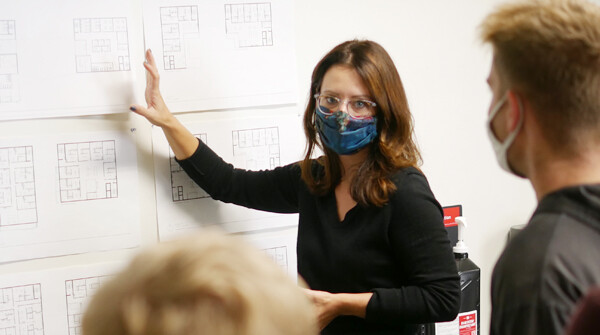
Who wouldn’t want to live in those areas of the world where people tend to live much longer than the rest of the population?
That’s the idea behind the College of Architecture’s fourth-year collaborative studio sponsored by Omaha-based RDG Planning and Design.
The undergraduate design studio is exploring incorporating healthy living, immersive, lifestyle options into their senior living design projects.
“We want the students to design a place people look forward to going to when they retire — a place where grandkids are excited to visit,” said studio co-instructor and RDG architect and senior partner Nate Gieselman. “So the challenge is, how do we create that place? That’s what we are researching and exploring in our design studio.”
The studio is attempting to capture the essence of research-based, longevity by incorporating elements of that environment and lifestyle, including local markets, restaurants, walking trails, art therapy, yoga/meditation studios, gardens and more into their designs.
Because the class is a multi-disciplinary studio, it is being co-taught by three RDG employees — Gieselman, architectural intern Adam Wiese and interior designer/senior partner Catrina Cook.
“Because we are all working professionals, having this co-taught has been really beneficial,” Gieselman said. “Sometimes we can’t all be there for studio, so that extra person for teaching coverage has been great.”
When RDG originally discussed the collaboration arrangement with Katherine Ankerson, dean of the College of Architecture, the studio was designed to have two days of in-person instruction and one day of Zoom teaching. With the onset of the COVID pandemic, however, the course delivery was adapted to one day a week of in-person instruction and the rest of the week done remotely.
“We’ve been doing Zoom for a decade, running projects across the country from Omaha. So we know how to use it,” said Gieselman. “Zoom has really helped us tap into talent that teaching a traditional studio might not have allowed. Catrina is based out of our St. Louis office and would not have originally been able to be here physically for all the studios; with Zoom technology and this new hybrid studio format, we can bring her in for the duration and give students the best possible instruction.”
According to instructors Gieselman and Wiese, a major benefit of the hybrid studio format is that students gain experience with presenting online.
“You think a generation that has grown up with technology would be adept at presenting online, but that is not necessarily the case – at least not from our observations,” said Gieselman. “This studio and new format are giving students the skills they need to succeed in the design profession.”
“The format of this semester being a hybrid between in-person and video meetings has helped to prepare me for my future career immensely,” said interior design student Courtney Riedmann. “Adam, Nate and Catrina have communicated the importance of a well put together digital presentation because that is how information is increasingly having to be communicated in the field, especially due to COVID-19.”
Fostering connections and collaborations with the professional community is one of the initiatives put forth in the college’s Strategic Plan.
“The RDG studio is one of several studio opportunities our students have this semester to connect and build relationships with professionals and potential employers,” said Ankerson.
Those connections have real added value for design students.
“Having knowledgeable instructors who practice in the industry is something I truly look forward to and deeply enjoy. For me as a student selecting instructors like RDG allows me to tailor my education to develop myself into the well-rounded architect I wish to become,” said architecture student Trey Erwin.
It was not too long ago that Wiese was sitting in one of the studios as a student himself.
“As a 2018 graduate of this program, it has been very rewarding to help teach the next generation of designers at UNL,” said Wiese. “This studio is exploring different ways design can enrich the human experience in the later phases of life, and it’s inspiring to be a part of that. I’m looking forward to our next collaborative studio together.”







